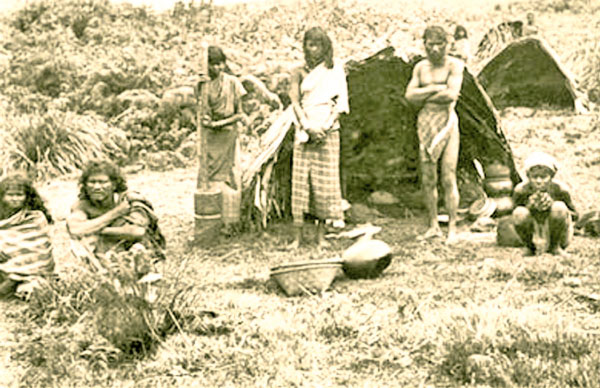Colombo city is being transformed and her skyline keeps changing. A few buildings stand to remind us of the vintage era of Ceylon. Thirty years ago, many of us would recall the appearance of sasthara women walking about with the bold proclamation of being able to tell your future by reading your palm. Their prophetic lips were laced red by chewing betel leaves. They walked down our neighbourhood in pairs or sat at the local market in small groups of three. The more dominating and loud mouthed of these women displayed a golden mookuthi (nose ring).
I personally doubted their skill at looking into anyone’s future, yet we still remain a nation influenced by superstition and myths. These talkative gypsy women were accompanied by a solitary male, now and then. The man wielded his own aura of occult mystery by controlling a deadly King Cobra which was placed in a basket. Some gypsy men would dazzle children using a trained monkey. Has this era of digital dominance and tech gadgets suddenly uprooted the mystic gypsy women and men from our society?
Unclear origins
There is no recorded history about the entry of this clan into Ceylonese society. Some opine that these Telugu-speaking people came from Andhra Pradesh, India, as early migrants. With time, we began to refer to them as Ahikuntika clan, the word deriving from ahi which means serpent. The gypsy men were experts at snake charming. For decades, they lived as outcasts and nomads, in makeshift tents, having no access to education.
India is a mega mix of many ethnic cultures and perhaps the gypsies who migrated to old Ceylon came from the Sapera clan in North India. Again, this tribe was considered outcast in Hindu society. The entire village earned a living by snake charming and the selling of anti-venoms. While it is difficult to find members of the ‘original’ clans, we can find clusters of gypsy families residing in remote villages of Anuradhapura, Akkaraipattu, Nawalapitiya, Puttalam, Chilaw, Trincomalee and Avissawella.
Some opine that the gypsy clan is somehow connected to the Rodiya, an old nomadic clan who later began to speak Sinhalese. It is assumed that the word ‘Rodiya’ is from the Sanskrit word ‘rudra’ which means hunter. If so, what did they hunt and what made them abandon hunting? Where did they learn the art of palm reading?
The legend of the Rodiya is bizarre as it has to do with an ancient Princess Ratnavalli. A hunter used to deliver venison to the palace and one day he is said to have given the king the flesh of a young boy. Thereafter, unknowingly, Ratnavalli had wanted to eat this meat again and the cunning hunter obliged. When the king found out the truth, he is said to have banished his daughter and gave her in marriage to a scavenger. The Rodiya are said to be her offspring. There is no evidence to prove this story.
Hope or fate
Since ancient times, snakes have been associated with many cults and fertility rituals. Egyptian pharaohs employed magicians and sorcerers. Women belonging to ancient cults used to dance naked with snakes dangling on their shoulders. We don’t know how the art of snake handling was mastered by the gypsy men.
As curious kids, we thought that the snakes were captivated by the long notes of the flute used by the gypsy. I later learnt from the Animal Planet channel that snakes don’t have external ears; they only feel certain low-frequency rumbles. Herpetologists agree that the swaying motion of the reed flute captures the total attention of the serpent as it rears its head from the cane basket: he perceives the moving flute as a threat. So technically, the snake really gazes at the flute and is not ‘charmed’ by the somewhat eerie music.
Many Sri Lankans are obsessed with knowing what the future beholds for them. It is the same in other South Asian nations. Then again, we have clairvoyants in developed nations. Coming back to the sun-tanned ‘sasthara’ women, they attempt to predict (and boldly manipulate) the customer’s future by reading a person’s dominant palm. The study of palm lines (chiromancy) has existed in ancient India, China, Persia, Tibet, Babylon and Palestine. It is believed the gypsy women look at seven lines on the hand: life line, head line, heart line, venus line, sun line, mercury line and fate line. It is indeed strange that the gypsy clan has now reached the end of the line, themselves.
Obscured by faith
Back in the day, the gypsy woman accepted a portion of paddy or a coconut as payment but with time, they began soliciting money. I have heard funny stories where the agreed amount was not given by the customer (who would have expected a sugar-coated prophecy) and the angered gypsy women would vigorously curse that stingy soul. Over the past five years, I have noticed a few ‘duplicate’ fortunetellers, trying to copycat the gypsy women in Colombo, Galle and Jaffna. It was amusing to watch them answer their smart phones.
Apart from displaying their limited skill of snake charming and palm reading, the gypsy community in Ceylon had no income-making trade skills. As we made the vibrant transition to being Sri Lanka, these nomads were truly lost. Desperate to survive, some gypsies gladly adapted to intermarriage, with Sinhalese and Tamil families. These folk are employed as labourers in the salterns of Puttalam. Others have taken to fishing and others struggle to survive by doing odd jobs.
The last of these families are fading into oblivion. The once colourful and superstitious gypsy community had their own rites and rituals. Whatever their shortcomings as a clan, they too were once part of our history, though it be a small and insignificant chapter. As the years roll by, the young generation will not be influenced by superstition. The gypsy’s lips have become silent. The snake charmers flute is losing its melody.



Add new comment